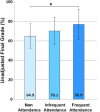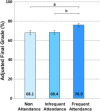Students helping students: Evaluating a pilot program of peer teaching for an undergraduate course in human anatomy
- PMID: 26060978
- PMCID: PMC5033067
- DOI: 10.1002/ase.1543
Students helping students: Evaluating a pilot program of peer teaching for an undergraduate course in human anatomy
Abstract
The educational literature generally suggests that supplemental instruction (SI) is effective in improving academic performance in traditionally difficult courses. A pilot program of peer teaching based on the SI model was implemented for an undergraduate course in human anatomy. Students in the course were stratified into three groups based on the number of peer teaching sessions they attended: nonattendees (0 sessions), infrequently attended (1-3 sessions), and frequently attended (≥ 4 sessions). After controlling for academic preparedness [i.e., admission grade point average (AGPA)] using an analysis of covariance, the final grades of frequent attendees were significantly higher than those of nonattendees (P = 0.025) and infrequent attendees (P = 0.015). A multiple regression analysis was performed to estimate the relative independent contribution of several variables in predicting the final grade. The results suggest that frequent attendance (β = 0.245, P = 0.007) and AGPA (β = 0.555, P < 0.001) were significant positive predictors, while being a first-year student (β = -0.217, P = 0.006) was a significant negative predictor. Collectively, these results suggest that attending a certain number of sessions may be required to gain a noticeable benefit from the program, and that first-year students (particularly those with a lower level of academic preparedness) would likely stand to benefit from maximally using the program. End-of-semester surveys and reports indicate that the program had several additional benefits, both to the students taking the course and to the students who served as program leaders.
Keywords: anatomy teaching; gross anatomy education; health sciences education; higher education; learning strategies; peer teaching; student attitudes; supplemental instruction; undergraduate education.
Published 2015 American Association of Anatomists.
Figures



References
-
- Arendale DR. 1994. Understanding the supplemental instruction model. New Dir Teach Learn 11–21.
-
- Bentley BS, Hill RV. 2009. Objective and subjective assessment of reciprocal peer teaching in medical gross anatomy laboratory. Anat Sci Educ 2:143–149. - PubMed
-
- Blanc R, Martin DC. 1994. Supplemental instruction: Increasing student performance and persistence in difficult academic courses. Acad Med 69:452–454. - PubMed
-
- Blanc RA, DeBuhr LE, Martin DC. 1983. Breaking the attrition cycle: The effects of supplemental instruction on undergraduate performance and attrition. J High Educ 54:80–90.
-
- Bridgham RG, Scarborough S. 1992. Effects of supplemental instruction in selected medical school science courses. Acad Med 67:S69–S71. - PubMed
Publication types
MeSH terms
LinkOut - more resources
Full Text Sources
Other Literature Sources
Medical

